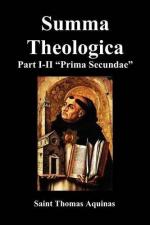I answer that, A precept may be figurative in two ways. First, primarily and in itself: because, to wit, it is instituted principally that it may be the figure of something. In this way the ceremonial precepts are figurative; since they were instituted for the very purpose that they might foreshadow something relating to the worship of God and the mystery of Christ. But some precepts are figurative, not primarily and in themselves, but consequently. In this way the judicial precepts of the Old Law are figurative. For they were not instituted for the purpose of being figurative, but in order that they might regulate the state of that people according to justice and equity. Nevertheless they did foreshadow something consequently: since, to wit, the entire state of that people, who were directed by these precepts, was figurative, according to 1 Cor. 10:11: “All . . . things happened to them in figure.”
Reply Obj. 1: The ceremonial precepts are not figurative in the same way as the judicial precepts, as explained above.
Reply Obj. 2: The Jewish people were chosen by God that Christ might be born of them. Consequently the entire state of that people had to be prophetic and figurative, as Augustine states (Contra Faust. xxii, 24). For this reason even the judicial precepts that were given to this people were more figurative that those which were given to other nations. Thus, too, the wars and deeds of this people are expounded in the mystical sense: but not the wars and deeds of the Assyrians or Romans, although the latter are more famous in the eyes of men.
Reply Obj. 3: In this people the direction of man in regard to his neighbor, considered in itself, was subject to reason. But in so far as it was referred to the worship of God, it was above reason: and in this respect it was figurative. ________________________
THIRD ARTICLE [I-II, Q. 104, Art. 3]
Whether the Judicial Precepts of the Old Law Bind for Ever?
Objection 1: It would seem that the judicial precepts of the Old Law bind for ever. Because the judicial precepts relate to the virtue of justice: since a judgment is an execution of the virtue of justice. Now “justice is perpetual and immortal” (Wis. 1:15). Therefore the judicial precepts bind for ever.
Obj. 2: Further, Divine institutions are more enduring than human institutions. But the judicial precepts of human laws bind for ever. Therefore much more do the judicial precepts of the Divine Law.
Obj. 3: Further, the Apostle says (Heb. 7:18) that “there is a setting aside of the former commandment, because of the weakness and unprofitableness thereof.” Now this is true of the ceremonial precept, which “could [Vulg.: ‘can’] not, as to the conscience, make him perfect that serveth only in meats and in drinks, and divers washings and justices of the flesh,” as the Apostle declares (Heb. 9:9, 10). On the other hand, the judicial precepts were useful and efficacious in respect of the purpose for which they were instituted, viz. to establish justice and equity among men. Therefore the judicial precepts of the Old Law are not set aside, but still retain their efficacy.




